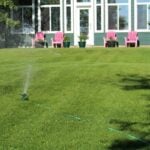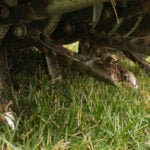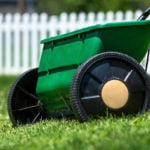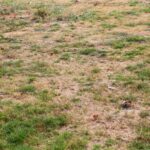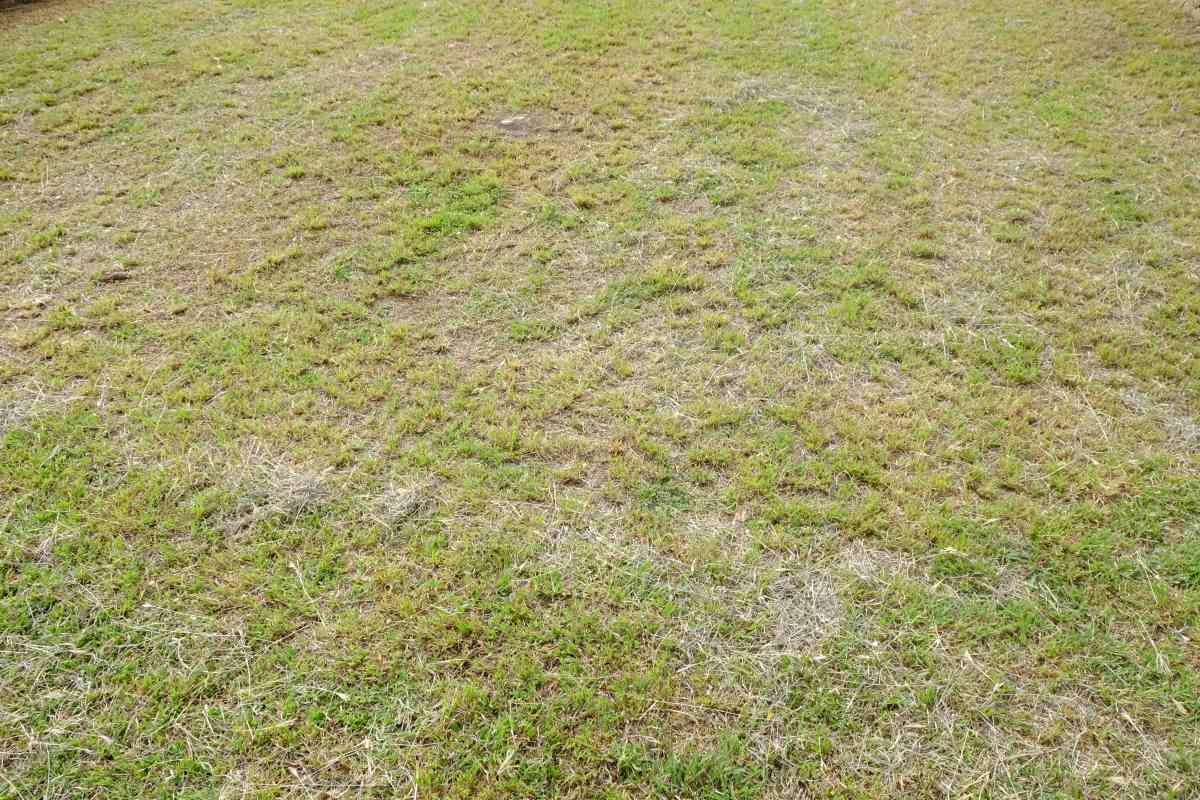
If your lawn looks brown and wilted, it’s screaming out for help. Are you wondering when and how to treat a heat-stressed lawn? The answer is ASAP. Give your grass a deep soak, and keep the mower blade high.
Depending on the damage or drought severity, your lawn might need more care and patience to heal. It’s a good idea to keep off the grass as much as you can. Here’s how you can spot when your grass is stressed and give it the care it needs to perk up again.
When to Treat a Heat-Stressed Lawn
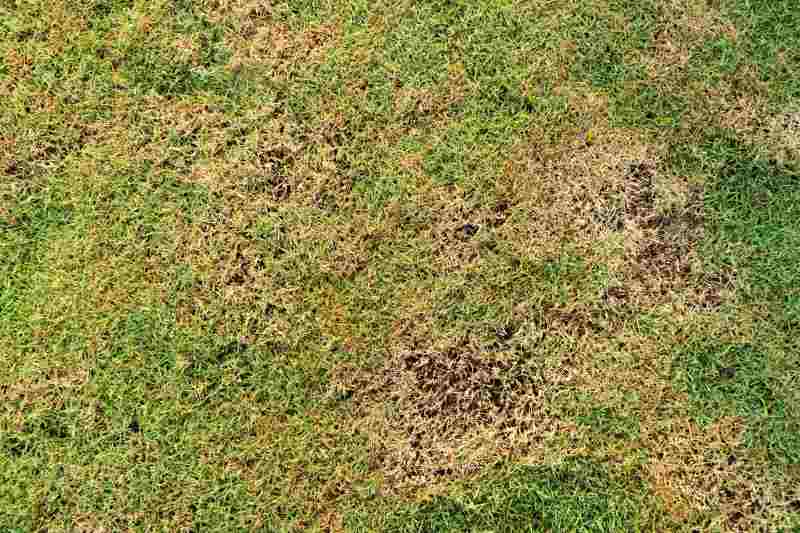
Treat your lawn as soon as it shows the early signs of heat stress. Do not wait.
When your lawn is feeling the burn from some serious sun action and not enough rain, it’s time to take action. When those temps stay up, and there isn’t a drop of water in sight, your grass is at risk of becoming stressed and damaged. If not treated in time, such distress can cause severe harm, including:
- Wilting
- Yellowing
- Browning patches
- Bare spots
It’s important to note here that not all grass blades are born equal in the face of heat. Cool-season grasses thrive in temperatures between 60 to 75 degrees Fahrenheit, while warm-season grasses prefer anything between 75 to 85 degrees Fahrenheit. When the mercury rises past these optimal levels, all types of grass may struggle to maintain their health and vibrancy.
Early Signs of a Heat-Stressed Lawn
A heat-stressed lawn can start to show symptoms within several days of experiencing high temperatures and little to no water. To save your grass before it’s too late, be mindful of the following signs:
- Persistent Footprints: If footprints linger after you’ve walked across the lawn, it’s a cry for help from your lawn. Healthy grass should be resilient and bounce back into shape quickly.
- Discoloration: Blades that are usually a vibrant green begin to look dull gray-green or take on a bluish tinge, indicating dehydration. This color change is akin to a flare in the night – something’s not quite right.
- Curling Foliage: If your turf seems to be curling like they’re trying to hide from the heat, it is essentially going into survival mode trying to conserve whatever moisture it has left. This clear stress signal from your lawn mustn’t go unheeded.
- Hard Ground: Test the texture of your soil with a simple screwdriver test; if you’re facing resistance as you try to push the tool into the ground, it’s a sign that your soil is compacted and severely parched. This is a massive red flag that your lawn is at risk.
As you spot these early warning signs and the thermometer continues to clock in at 85 degrees Fahrenheit day after day, it’s time to swing into action with immediate intervention. Letting things slide until large swaths of brown invade your once-green turf could land you with a dead lawn and a heavy reseeding bill.
How to Protect Your Lawn From Heat Stress
If you’re dealing with some hot weather, your grass will suffer no matter how much love you give it. But the better shape it’s in and the sooner you start helping it out, the better chance it has to hang in there.
Good watering techniques will lessen the damage and give your lawn a leg up in bouncing back once things cool off. When hydrated properly and regularly, your grass can endure higher temperatures much better. It isn’t just about switching on your sprinkler or irrigation system, though – it’s also about how often and when you water it.
Other heat stress prevention tips include proper mowing practices, avoiding foot traffic, and minimizing fertilization. The key is to practice good lawn care to ensure optimal turf health and strength.
Quench the Turf’s Thirst
The number one tip: don’t drown your grass with water in the summer. It can make roots weak and less able to deal with heat. Just give it enough to stay healthy.
Here are some guidelines for watering your heat-stressed lawn:
- Water Deeply and Infrequently: If your lawn needs a drink, make it a large one. Instead of sprinkling tiny sips regularly, allow the water to seep down into the soil by watering less often but more heavily. Try to provide about 1 to 1.5 inches of water per week. This will penetrate the soil to a depth of around 6 inches, allowing the roots of your grass access to water deeper in the ground.
Such deep and infrequent watering encourages the root system of your grass to grow deeper, making it more resilient against heat and drought.
- Water Early in the Morning: The best time to water your lawn during hot months is between 5 AM and 9 AM.
This early morning window works on several fronts: First, it’s usually cooler and calmer at these hours, so less water is lost to evaporation. Second, you give the grass plenty of time to soak up all that hydration and dry off before nightfall, reducing the probability of fungal diseases taking root.
(Here is our guide on ‘When is the Best Time to Water Your Lawn in Hot Weather?’)
- Consider Using a Sprinkler: A more efficient way to water your lawn is by using a sprinkler. Pulsating, impact, or oscillating ones are good choices for large lawns since they offer even water dispersal across a significant area. Such irrigation systems prevent overwatering parts of your lawn and are easier than standing with a garden hose, saving you effort and time.
Pro tip: Gauge your watering accurately with tools like a rain gauge or an emptied tuna can. Turn off the sprinkler when these collect 1 to 1.5 inches of water.
Mowing Practices to Reduce Heat Stress
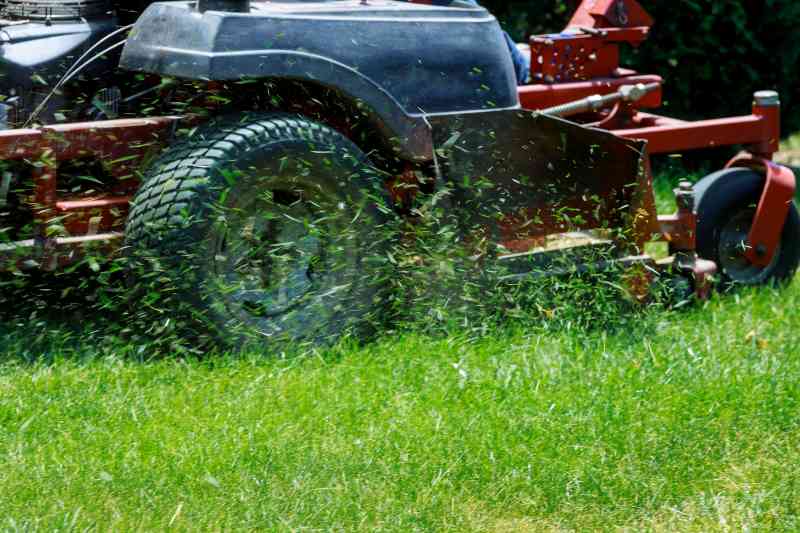
You might feel a bit nervous about taking sharp blades to your grass when it’s clearly having a hard time. It’s an understandable concern; however, if done right, mowing can be good for your lawn during a heatwave. Here are a few tricks you can whip out to give it some relief:
- Raise Your Mower’s Blade: It might feel odd at first when you’re used to neatly manicured grass. But aiming for longer lawns can benefit those stressed-out blades. Taller grass shades the soil, blocking rapid water evaporation. Plus, more leaf surface area means more photosynthesis and healthier turf.
- Mow Less Frequently: Now, more isn’t always better – especially when we’re talking about trimming your lawn during a heatwave. By easing up the frequency of mows, you spare the grass from additional stress. So forget that ‘mow every week’ rule and switch to once every ten days instead.
- Leave Grass Clippings: Rather than sending your grass clippings off with the garden waste, simply leave them on your lawn. They’ll share their nutrients with their root siblings while providing much-needed shade.
- Keep the Blades Sharp: A dull blade is just as bad for your grass as scissors are for hair. Rather than snipping cleanly through each blade, they tear and rip, causing ragged tips that are perfect targets for sun scorch or disease settlement. So sharpen up those blades and ensure a clean slice with each mow.
Avoid Foot Traffic
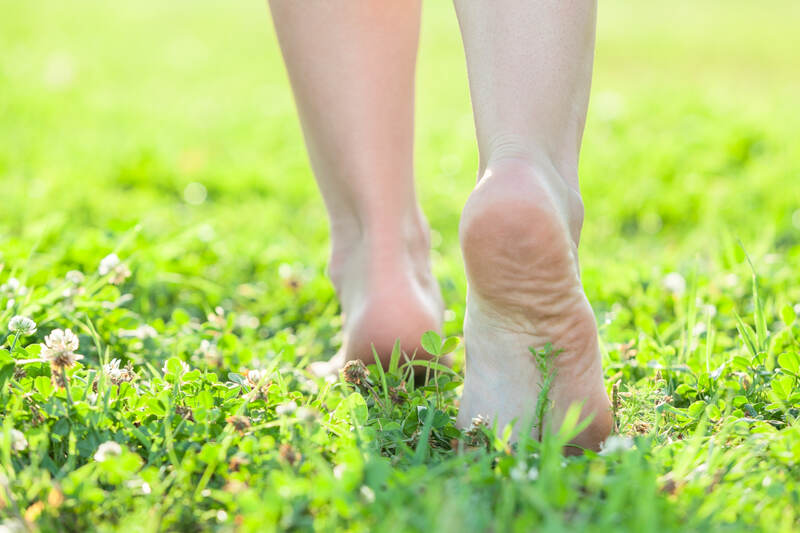
When the sun beats down relentlessly, something as simple as foot traffic can spell more trouble for your heat-stressed lawn. The blades are already lightweight from dehydration. Add heavy footfall to the mix, and they won’t have the strength to bounce back. Plus, every step you take compacts the soil, making it harder for the roots to breathe.
So aim to minimize strolls across your yard during these times – a small gesture that makes a big difference in preserving its health.
Minimize Fertilizer

While you might think about fertilizing when you see a lawn problem, it’s not recommended for grasses during severe summer heat, especially cool-season grasses. If nutrition is extremely low, a small amount of slow-release fertilizer may help warm-season grass.
When a lawn suffers from traumatic weather conditions like extreme dryness or scorching sun rays, it has to work harder to sustain its existing biology, let alone manage added growth. By fertilizing during this time of heat stress, you’re encouraging the plant’s desire for growth when it doesn’t have enough resources (like moisture) to fuel such expansion. Therefore, the new shoots are likely to dry out or die off.
The best idea is to put away the fertilizer bags until cooler days arrive. Once temperatures drop below 85 degrees Fahrenheit or so and your grass begins to show signs of recovery, additional nutrients needed for overall health can effectively play their part. So, be patient, wait out the last of the summer heat storms, and only then roll up your sleeves to begin feeding for the fall.
However, there are certain conditions in which fertilization can help mitigate your lawn’s distress during extreme temperatures:
- When Nutrients Are Low: If your soil analysis shows that the nutrient levels are too low, supplementing warm-season grass with a gentle, slow-release fertilizer could give your grass the boost it needs.
Using organic fertilizers such as liquid seaweed or fish emulsion helps to strengthen grass cell walls and enhance resistance to heat stress. These natural options can improve soil health by enhancing its water-holding capacity and promoting beneficial microbial activity. Remember, it’s best to avoid synthetic chemicals when it’s super hot out.
- After Aeration: This aeration process can greatly relieve heat stress by breaking up compacted soils and improving root health. Following up with some nutrition (in small amounts) can be beneficial post-aerating.
*Note: Just to be safe, consult a local lawn pro before adding anything to your heat-stressed lawn.
How to Recover a Heat-Stressed Lawn
After the charred and harsh days of summer begin to retire, and your lawn has had time to take some essential hydration, it’s time to move from triage into recovery mode. Depending on the extent of the heat damage, this could either be straightforward or a bit lengthy.
Here’s how to nurse your lawn back to good health post-summer stress:
Assess the Damage
Once your lawn is free of the intense summer heat and you start to water regularly again, take a walk across it and study its conditions. Has it recovered somewhat with regular watering or are there still several dry brown patches? Knowing where to focus your recovery efforts will make the job easier.
*Note: If there’s a green growth peeping through, that’s a good sign. It means your lawn is bouncing back from its dormant state. However, if your grass remains brown and barren with no sign of growth, it might be an indication that part of your turf went beyond heat stress and didn’t survive the harsh summer. In this case, you might need to consider reseeding or laying new sod.
Aerate (If Needed)
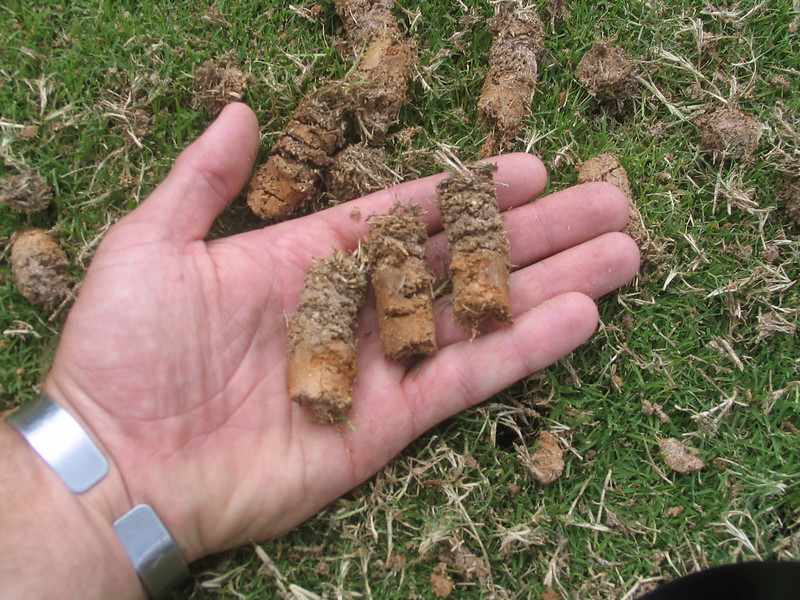
Are the top few inches of your soil hard and compacted? If yes, then aerating your lawn might just be the comeback punch it needs to thrive again (especially if you skipped aeration in the spring or fall.)
During high temperatures, the soil can pack down hard (compaction), cutting off what your grass needs most – air, water, and food. Aerating is like giving your lawn a deep breath of fresh air. It loosens up the dirt so everything good can get down to the roots.
*Note: Depending on your type of grass, there is a specific ‘best time’ to aerate your soil. For cool-season grasses, early fall is the top choice for aeration. For warm-season grasses, late spring to early summer is best. So coordinate your recovery effort schedules accordingly or consult with a lawn pro to decide the optimum time.
(Here is our guide on How to Aerate a Lawn.)
Overseed
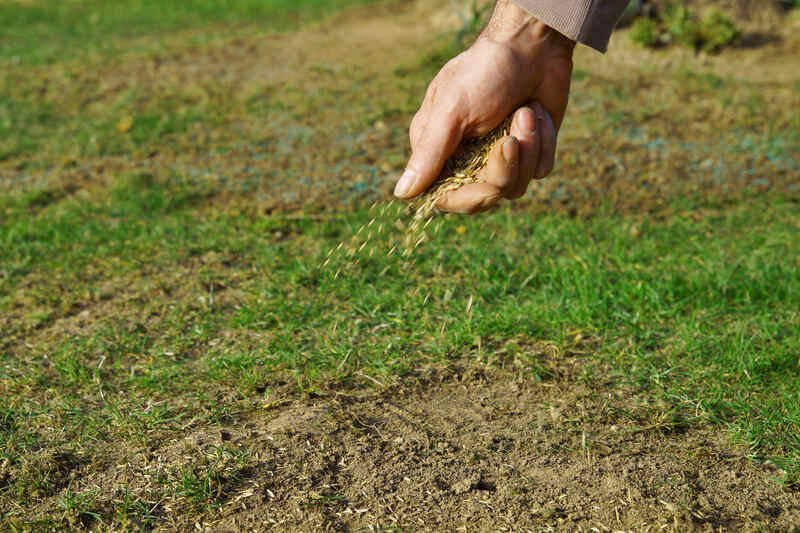
Once the heat of summer has passed, your lawn might still bear scars from its heated battle. Brown patches or bare spots are common aftermaths of a long-standing drought or scorching temperatures. These could be signs that you need to overseed your lawn.
Early fall is an excellent period to overseed or reseed cool-season grasses, while the end of spring is ideal for warm-season species. So if you have a warm-season lawn, you’ll need to exercise patience. (Here is our guide on How to Overseed a Lawn in 8 Simple Steps.)
Some rules of thumb for successful overseeding are:
- Avoid Rash Actions During Summer: If your lawn features chunks of dried-up, dead grass from the brutal heat waves, don’t be quick to pull them out. The mid-summer sun can further stress any surviving grass plants and expose bare soil that’s a warm welcome for weed seeds. Instead, let the dead patches be. You’ll have ample opportunity to replace the dead blades later.
- Timely Reseeding or Resodding: If your area is prone to hard frosts, ensure you complete any reseeding or resodding tasks at least 6 to 8 weeks before the first expected frost date. Otherwise, the new grass will not have enough time to become established and strong before its dormant winter period hits.
Was the summer heat so bad that you now need to revive a dead lawn? Here’s our comprehensive guide on How to Revive a Dead Lawn, complete with all the professional tips you need.
Dormancy vs. Dead Grass
Dormant grass will often look brown and dry, resembling a straw-like texture – very similar indeed to dead grass. However, the dormancy phase is just grass’s ingenious trick of protecting itself during harsh conditions. It shuts down and heads undergrow to conserve water. Usually, if temperatures return to normal, all the lawn needs is a good soaking, and it can come back to life in all its vibrant green glory.
*Note: The timing of summer dormancy varies by the type of grass. For warm-season lawns, it may occur during intense heat in late summer, while cool-season grasses typically enter dormancy in early summer when temperatures and drought conditions warrant.
With truly dead grass, on the other hand, bringing it back from beyond isn’t quite so simple. Dead grass won’t perk up again even after thorough watering; its roots will also die. One easy way to check for life is lightly tugging on the turf. If it pulls out easily with no signs of roots attached, your grass might need to be replaced.
If you’re interested in learning more about the difference between dormant and dead grass, take a quick peek at our article titled Dormant Grass vs. Dead Grass.
FAQ About Heat-Stressed Lawns
What is a stressed lawn?
A stressed lawn refers to a yard that is struggling due to external pressures. This could be because of extreme or inconsistent weather conditions, pests or diseases, over- or under-watering, poor soil conditions, or even incorrect mowing practices. Essentially, any factor that causes discomfort to your lawn’s natural growth and maintenance cycle can put it under stress.
How can I prevent my lawn from getting heat-stressed?
Prevention is always better than cure, at least where your lawn is concerned. Deep and infrequent watering helps build deep roots, which handle drought stress better. Early morning or late evening are the best times to water when evaporation rates are lower.
Also, a high mower setting allows grass to shade the soil, preventing excess evaporation and maintaining surface temperatures to keep it cool during hot days.
Are certain types of grass more heat-resistant?
Every grass type has its own strengths and weaknesses. Bermudagrass, St. Augustinegrass, and Zoysiagrass are known for their heat tolerance and thrive in southern regions with high temperatures. Just remember to choose a grass that thrives in your area.
Pros to the Rescue: Bring Your Heat-Stressed Lawn Back to Life
You might just want to kick back with an ice-cold beverage after a long day in the sun. Yet, when your lawn starts fading and showing signs of heat stress, you must take immediate action. Water your lawn properly, mow strategically, and limit foot traffic as much as possible.
When your DIY attempts don’t cut it, bring in a local lawn care pro to check and fix your heat-stressed grass. They know their stuff regarding lawn fixes and can give you the lowdown on keeping your turf in top shape all year, even through the blazing summers.
Main Photo Credit: srckomkrit / Adobe Stock Free / License
